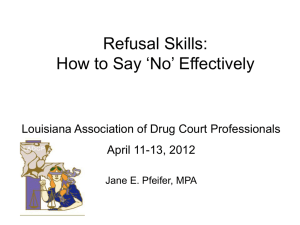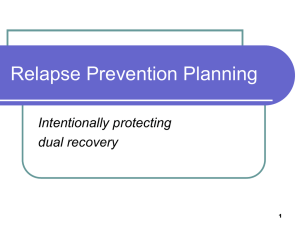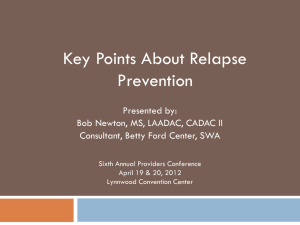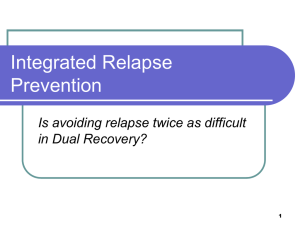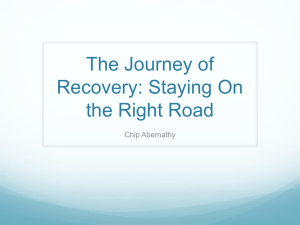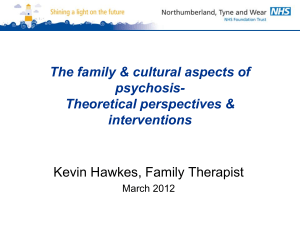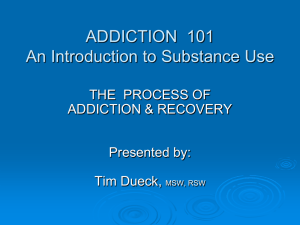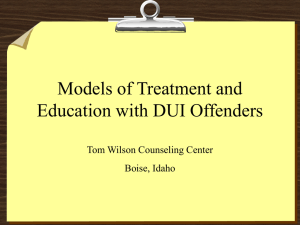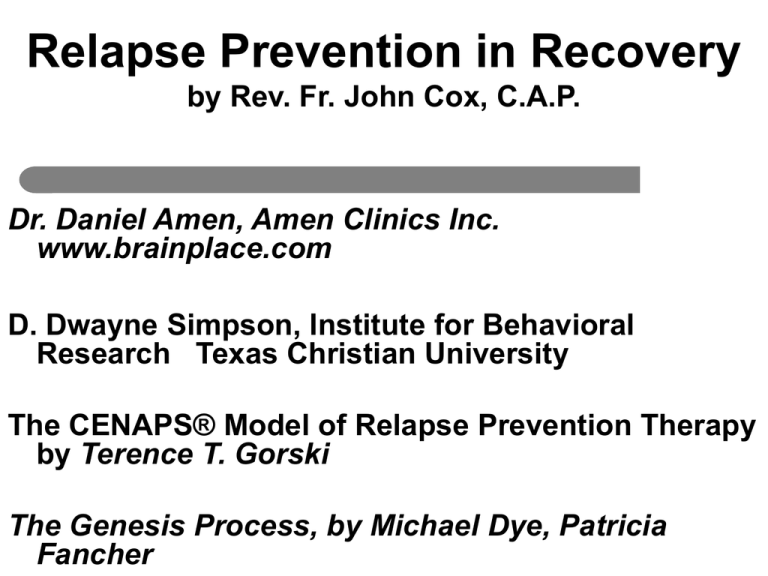
Relapse Prevention in Recovery
by Rev. Fr. John Cox, C.A.P.
Dr. Daniel Amen, Amen Clinics Inc.
www.brainplace.com
D. Dwayne Simpson, Institute for Behavioral
Research Texas Christian University
The CENAPS® Model of Relapse Prevention Therapy
by Terence T. Gorski
The Genesis Process, by Michael Dye, Patricia
Fancher
Relapse Prevention Recovery Issues
• Intro to the Stages of Recovery and Relapse
• An Evidence-Based Treatment Model for
Improving Practice
• Relapse – Spirit, Soul, Body
• Access To Recovery as Relapse Prevention
Energy
• CENAPS® Model of Relapse Prevention
Therapy
• Stages of Relapse and Recovery
• The Genesis Process: The FASTER Scale
Issues con’t.
•
•
•
•
•
•
Structure of Recovery
Triggers
Recovery Information Issues
Relapse Prevention Factors
A Client’s Relapse Prevention Plan
Your Relapse Prevention Plan
Addiction
A chronic but
treatable condition
(“relapses” are common -like other diseases)
Relapse Rates & Tx Compliance
for Medical Conditions
% Relapsed (Mdn) in 1 Yr
% Complied w Trt Plan
50
70
55
40
30
Diabetes
Hypertension
30
Asthma
O’Brien & McLellan, 1996, The Lancet
STAGES OF RECOVERY
What Is Relapse Prevention Treatment?
Relapse prevention is a systematic method of
teaching and coaching recovering patients to
recognize and manage relapse warning signs.
Relapse prevention becomes the primary focus
for patients who are unable to maintain
abstinence from alcohol or drugs despite
primary treatment.
STAGES OF RECOVERY
Recovery is defined as abstinence plus a full
return to bio/psycho/social/spiritual functioning.
Relapse is defined as the process of becoming
dysfunctional in recovery, which leads to a return
to chemical use, physical or emotional collapse, or
suicide.
Relapse episodes are usually preceded by a series
of observable warning signs.
STAGES con’t.
Typically, relapse progresses from bio,
psycho, social and spiritual stability through
a period of progressively increasing distress
that leads to physical, emotional, and
spiritual collapse.
The symptoms intensify unless the individual
turns to the use of alcohol or drugs for relief.
WHERE’S YOUR
HEAD AT ?
BRAIN SPECT SCANS
And Brain Damage
from Addictions
Single Photon Emission Computerized Tomography.
NUCLEAR MEDICINE
Stimulant Craving Response Sequence
Addictive, Limbic Dissociation
Trigger
Thought
Craving
Use
An Evidence-Based
Treatment Model for
Improving Practice
D. Dwayne Simpson
and Colleagues
Texas Christian University
12
Institute of Behavioral Research
at Texas Christian University
IBR HOME PAGE
WHAT’S NEW
ABOUT IBR
STAFF
PROJECTS
NEWSLETTERS
PUBLICATIONS
PRESENTATIONS
MANUALS
FORMS
OTHER LINKS
SITE GUIDES:
Search
Contents
Site map
IBR
The IBR specializes in the study of drug abuse treatment – including new
interventions, therapeutic process, and outcomes.
TCU Resource
Collections:
Spotlight…_______________
National Treatment
Evaluations
• New studies on “transferring research to
practice” were recently published in a
special issue of Journal of Substance Abuse
Treatment
Correctional Treatment
Evaluations
• The latest Research Roundup Newsletter is
out, focusing on IBR technology transfer
research
Cognitive Interventions
• Handouts from presentations available
Treatment Process
Counseling Manuals
Technology Transfer
Client/Treatment
Assessments
• Core Forms & Research Summaries
available
DATOS
• Publication Abstracts available
www.ibr.tcu.edu
Summary
PowerPoint
Presentations
Elements of a Treatment
Process Model
Patient
Factors
Detox
Psychological
Functioning,
OP
Motivation,
TC/Res
& Problem
Severity
OP-MM
?
Sufficient
Retention
Drug
Use
Crime
Social
Relations
Posttreatment
Cognitive and behavioral
components with therapeutic impact
Interventions Should
Maintain This Process
Motiv
Patient
Attributes
at Intake
Early
Engagement
Early
Recovery
Program
Participation
Behavioral
Change
Sufficient
Retention
Therapeutic Psycho-Social
Relationship
Change
Drug
Use
Crime
Social
Relations
Posttreatment
Simpson, 2001 (Addiction)
Threats from Growing
Economic Pressures
Limit “wrap-around” services
Minimize treatment duration
Shift “aftercare” to
community
Reduce outcome
accountability
The shift towards
Access To Recovery
as Relapse Prevention Energy
The CENAPS® Model of Relapse Prevention
Therapy (CMRPT®)
by Terence T. Gorski
The Genesis Process: The FASTER Scale by
Michael Dye
Recovery Support Services
Services aimed at removing barriers and opening
natural pathways to addiction recovery.
They include transitional housing, recovery
homes, day care to increase access to support
meetings, sobriety-conducive employment,
educational access, debt management, budget
counseling, sober fellowship, as well as
traditionally defined treatment services.
Recovery Support con’t.
The overall goals are to remove
barriers to recovery; to create positive
space (sober sanctuary) where
recovery can grow.
See William White’s work.
Recovery Support Services
Professionally-directed treatment services are
not the same as the broader umbrella of recovery
support services.
Those who lack professional training should not
be involved in the former, while the latter may be
best designed and delivered by the recovery
community.
Those providing treatment services and those
providing recovery support services play different
but complimentary roles in the long term recovery
process.
The CENAPS® Model of Relapse
Prevention Therapy (CMRPT®)
5 Goals and Objectives of Approach:
Assess the global lifestyle patterns contributing to
relapse by completing a comprehensive selfassessment of life, addiction, and relapse history.
Construct a personalized list of relapse warning
signs that lead the relapser from stable recovery
back to chemical use.
The CENAPS® Model of Relapse
Prevention Therapy (CMRPT®)
5 Goals and Objectives of Approach (cont.):
Develop warning sign management strategies for the
critical warning signs.
Develop a structured recovery program that will allow
clients to identify and manage the critical warning signs as
they occur.
Develop a relapse early intervention plan that will provide
the client and significant others with step-by-step
instructions to interrupt alcohol and other drug use should
it recur.
Recovery and Relapse Processes
To understand the progression of warning
signs, it is important to look at the dynamic
interaction between the recovery and
relapse processes.
Recovery and relapse can be described as
related processes that unfold in six stages.
Recovery and Relapse Processes:
6 Stages
1. Abstaining from alcohol and other drugs.
2. Separating from people, places, and things
that promote the use of alcohol or drugs,
and establishing a social network that
supports recovery.
Recovery and Relapse Processes:
6 Stages
3. Stopping self-defeating behaviors that
prevent awareness of painful feelings and
irrational thoughts
4. Learning how to manage feelings and
emotions responsibly without resorting to
compulsive behavior or the use of alcohol
or drugs
Recovery and Relapse Processes:
6 Stages
5. Learning to change addictive thinking
patterns that create painful feelings and
self-defeating behaviors
6. Identifying and changing the mistaken core
beliefs about oneself, others, and the
world that promote irrational thinking.
Recovery and Relapse Processes:
6 Stages
1. Have a mistaken belief that causes
irrational thoughts.
2. Begin to return to addictive thinking
patterns that cause painful feelings.
Recovery and Relapse Processes:
6 Stages
3. Engage in compulsive, self-defeating
behaviors as a way to avoid the feelings.
4. Seek out situations involving people who
use alcohol and drugs.
Recovery and Relapse Processes:
6 Stages
5. Find themselves in more pain, thinking less
rationally, and behaving less responsibly.
6. Find themselves in a situation in which
drug or alcohol use seems like a logical
escape from their pain, and they use
alcohol or drugs.
STAGES OF Relapse and Recovery
-1: Identify &
change
mistaken
core beliefs.
-2: Learning to
change addictive
thinking.
-3: Learning to manage
feelings responsibly.
-4: Stopping behaviors that
stuff painful feelings and
irrational thoughts.
-5: Separating from Drug Culture
and attaching to a “clean culture.”
-6: Abstaining from AODA.
-1: Embrace a mistaken belief
-2: Return of addictive
thinking and feelings
-3: Compulsive, self-defeating
behaviors to avoid the feelings
and relieve urges
-4: Seek out situations
involving people who
use alcohol and drugs
-5: more pain, less
rational, behaving less
responsibly
-6: Locate themselves
near drug or alcohol
use… and they use
alcohol or drugs.
The FASTER Scale: Genesis Process
Before relapse happens, many biological,
psychological and social changes affect our
neurochemistry.
Addicts speed up their avoidance behaviors,
increasing anxiety and anger to mask pain.
This depletes endorphins, causing
hopelessness and exhaustion.
In this state of exhaustion, addicts isolate
and feel they cannot cope without
chemicals.
The FASTER Scale: Genesis Process
Relapse is a predictable process.
It has identifiable stages, each of which has
a distinctive neurochemical basis.
The FASTER Scale is a neurochemical
model of relapse that identifies specific high
risk behaviors for each stage of the relapse
process.
The FASTER Scale: Genesis Process
Recovery….then procrastination…..
Forgetting priorities
Anxiety
Speeding up
Ticked off !
Exhausted
Relapse
To interrupt the descent into relapse, addicts must take responsibility
for where they are on the scale by becoming aware of their behavior
and make good choices to stop the downward spiral.
The FASTER Scale: Genesis Process
•Recovery….then
Procrastination!
Structure of Recovery
• Spirit: Relationship with God and Fellowship with
disciplines
• Soul: Accountable awareness of stages in thinking
and feeling health
• Body: Skills in craving reduction thru health in
sleep, diet, exercise, and triggers management
Structure of Recovery –
Importance
•
•
•
•
Counterpoint to addict lifestyle
Requires proactive behavior planning
Reduces “accidental” relapses
Cortical control of behavior vs. limbic control
of behavior
• Reduces anxiety/encourages self-reliance
• Operationalizes one day at a time
Structure of Recovery –
Creating a New Culture
•
•
•
•
•
•
•
•
Time scheduling
Attending 12-step meetings
Going to treatment
Exercising
Attending school
Going to work
Performing athletic activities
Relationships in church
Structure of Recovery –
Pitfalls
•
•
•
•
•
•
Scheduling unrealistically
Neglecting recreation
Being perfectionistic
Therapist imposing schedule
Spouse/parent imposing schedule
Single domain dominance of either bio,
psych, social, or spiritual
TRIGGERS
Triggers - Definition
A trigger is a stimulus which has been
repeatedly
associated
with
the
preparation for, anticipation of, or the
use of alcohol or other drugs.
These stimuli include people, places,
things, times of day, emotional states,
and secondary drug use.
Triggers - People
• Drug-using friends/dealer
• Voices of drug friends/dealer
• Absence of significant other
• Sexual partners in illicit sex
• Groups discussing drug use
Triggers - Places
• Drug dealer’s home
• Bars and clubs
• Drug use neighborhoods
• Freeway offramps
• Worksite
• Street corners
• Your ritual places
Triggers - Things
• Paraphernalia
• Sexually explicit magazines/movies
• Money/bank machines
• Music
• Movies/TV shows about alcohol and
• other drugs
• Secondary alcohol or other drug use
Triggers - Times
• Periods of idle time
• Periods of extended stress
• After work
• Payday
• Holidays
• Friday/Saturday night
• Birthdays/Anniversaries
Triggers - Emotional States
• Anxiety
• Fatigue
• Anger
• Boredom
• Frustration
• Adrenalized states
• Sexual arousal or deprivation
• Gradually building emotional states with no
expected relief
Non-Trigger Events
• Exercise
• Church activities
• AA meetings
• Any new recreation/hobby
• Structured/monitored periods
• Eating/sleeping
• Non-drug movies
Recovery Information Issues
•
•
•
•
•
•
•
•
Stimulant Craving Reduction Methods
Avoid trigger situations
Use thought-stopping
Use visual imagery
Pray
Snap rubber band
Change environment/behavior
Avoid moving toward secondary alcohol or
other drug use
• Call sponsor/therapist/accountability partner
Recovery Information Issues What
•
•
•
•
•
•
•
•
•
Substance abuse and the brain
Sex and recovery
Relapse prevention issues
Triggers and cravings
Emotional readjustment
Stages of recovery
Medical effects
Relationships and recovery
Cross/Switch Addictions
Recovery Information Issues Why
•
•
•
•
•
•
Reduces confusion and guilt
Explains addict behavior
Gives a roadmap for recovery
Clarifies alcohol/marijuana issue
Aids acceptance of addiction
Gives hope/realistic perspective for
family
Relapse Prevention Factors –
Sexual Behavior
•
•
•
•
•
•
•
•
Concern about sexual dysfunction
Concern over sexual abstinence
Concern over sexual disinterest
Loss of intensity of sexual enjoyment
Shame/guilt about sexual behavior
Sexual arousal producing craving
Sexual behavior and intimacy
Sobriety and monogamy
Relapse Prevention Factors Time Periods
•
•
•
•
•
•
•
Unstructured time
Transition periods
Protracted abstinence symptoms
Holidays
Chronic stress, fatigue, or boredom
Anniversary dates
Periods of emotional turmoil
Relapse Prevention Factors –
Addict Behavior
•
•
•
•
•
•
•
Lying/stealing
Having extramarital/illicit sex
Using secondary substances
Returning to bars/drug friends
Being unreliable/irresponsible
Behaving compulsively/impulsively
Isolating
Relapse Prevention Factors –
Addict Thinking
• Paranoia
• Relapse justifications:
– “I’m not an addict anymore”
– “I’m testing myself”
– “I need to work”
– “Other drugs/alcohol are OK”
– “Catastrophic events”
– “Negative emotional states”
Relapse Prevention Factors Relationships
•
•
•
•
•
•
•
Addict must deal with family’s:
Extreme anger and blaming
Unwillingness to change/trust
Hypervigilance - excessive monitoring
Sexual anxieties
Adjustment to non-victim status
Conflict with recovery activities
Relapse Prevention Factors –
Withdrawal Stage
•
•
•
•
•
•
•
Unstructured time
Proximity of triggers
Secondary alcohol or other drug use
Powerful cravings
Paranoia
Depression
Disordered sleep patterns
Relapse Prevention Factors –
Honeymoon Stage
•
•
•
•
•
•
•
Overconfidence
Secondary alcohol or other drug use
Discontinuation of structure
Resistance to behavior change
Return to addict lifestyle
Inability to prioritize
Periodic paranoia
Relapse Prevention Factors –
The Wall Stage
• Increased emotionality
Recovery plan structure dissolves
• interpersonal conflict
- Drifting Behavior
• Relapse justification
Secondary alcohol or drug use
• Anhedonia/loss of motivation
other drug use
• Resistance to exercise - Paranoia
• Insomnia/low energy/fatigue
-
-
Relapse Prevention Factors Adjustment Stage
•
•
•
•
Secondary alcohol or other drug use
Relaxation of structure
Struggle over acceptance of addiction
Maintenance of recovery
momentum/commitment
• Six-month syndrome
• Re-emergence of underlying pathology
How far am I in abstinence…………
plus a full return to bio/psycho/social/spiritual functioning?
-1: Identify &
change
mistaken
core beliefs.
-2: Learning to
change addictive
thinking.
-3: Learning to manage
feelings responsibly.
-4: Stopping behaviors that
stuff painful feelings and
irrational thoughts.
-5: Separated from Drug Culture
And attaching to a “clean culture.”
-6: Have I abstained from ______?
-1: Embrace a mistaken belief
-2: Return of addictive
thinking and feelings
-3: Compulsive, self-defeating
behaviors to avoid
the feelings
-4: Seek out situations
involving people who
use alcohol and drugs
-5: more pain, less
rational, behaving less
responsibly
-6: Locate themselves
near drug or alcohol
use… and they use
alcohol or drugs.

